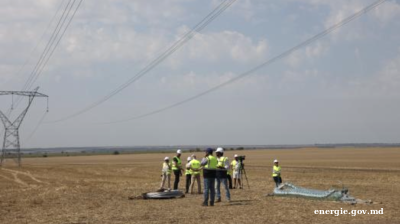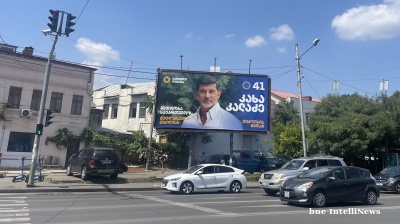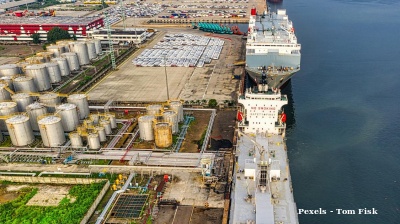Ukraine’s Prime Minister to ask IMF for new loan, as new team focuses efforts on bring US support back on board

Ukraine’s new prime minister, Yuliia Svyrydenko, said Kyiv will probably ask for a new International Monetary Fund (IMF) loan to plug a widening budget deficit.
In her first interview since taking office last week, Svyrydenko told Bloomberg News that an expanded IMF programme may be necessary given donor shortfalls and the prospect of the war continuing until at least the end of this year.
Svyrydenko, a close ally of President Volodymyr Zelenskiy, says that global donors have committed only half of the estimated $75bn required to fund Ukraine’s war-time budget over the next two years.
With the current IMF loan package worth $16bn set to expire in 2027, the upcoming review by the Fund in August will include a discussion of a new deal. “If the baseline scenario assumes the war will continue into next year, it is very likely we will have a new IMF program,” she said.
The 2026 state budget's external financing deficit will reach $19bn. Roksolana Pidlasa, head of the parliamentary budget committee, said that after adopting amendments to Ukraine's budget this year, its planned deficit will be $42bn (based on the estimated exchange rate), and there is no reason to think it will decrease next year. As a result, the need for external financing will remain at about $40bn.
"Partly, this need will be covered by the so-called non-repayable loans from the G7 countries (ERA loans), partly by EU assistance within the framework of the Ukraine Facility, and the IMF. At the same time, the external financing need for 2026 remains unmet of $19bn," she noted.
Earlier this month the Ministry of Finance (MinFin) said that it had already secured just under half of what is needed, but Ukraine remains short of $10bn-$15bn to close a hole in the budget Ukrainian investment bank said in a recent note.
“The key near-term challenge for the government is to secure an additional US$10-$15bn in funding for 2026 on top of the existing commitments of the foreign partners. We expect the IMF will substantially revise its unrealistic baseline scenario for the BoP and budget during the next review in December 2025 and will use much more conservative assumptions admitting the need for more external funding,” ICU said.
Ukraine’s Defence Minister Denys Shmygal is also on the hunt for more support. At the Ramstein defence meeting last week he asked for partners for an additional $6bn in funding for weapons after the Rada increased its military budget by $10bn to a total of $50bn for this year.
The military budget already accounts for 26% of GDP, according to some estimates, but ICU says if related security spending is added in the number rises to some 30% of GDP, and if foreign in-kind military assistance is included you get to 40%. Even this is not including official underreported bilateral aid or indirect assistance, such as intelligence sharing, which is sometimes significant.
“The total financial resource for defence and security in 2025 will amount to nearly $50bn. That is 26% of GDP,” he said speaking at the 14th meeting of the Ukraine Donor Platform’s Steering Committee, held on the sidelines of Ukraine Recovery Conference (UKR2025).
Thanks to the outgoing Biden administration and the start of payments of about $1bn a month that are part of the G7 $50bn loan to Ukraine, the country's international reserves are at a wartime high of some $45bn.
Funding used to be a joint US-EU enterprise, but since US President Donald Trump took over the US has provided Ukraine with no fresh grants or loans. The load is now being entirely borne by the EU and the G7 deal that is backed by profits from Russia’s $300bn of frozen Central Bank of Russia (CBR) reserve assets.
Svyrydenko was promoted in a recent reshuffle and partly chosen as she already is well known in Washington, where she successfully brokered the difficult minerals deal signed on April 30. Now Svyrydenko has been tasked to keep the Trump administration on board as a partner in the Ukraine struggle against Russia.
Likewise, Ukraine’s long-serving EU ambassador, Olha Stefanishyna, who has very strong contacts in Brussels, has also been reassigned last week and appointed Ukraine’s Special Envoy to the US to help in the lobbying efforts. Shmyhal was demoted from the job of Prime Minister in the shake up but appointed Defence Minister as he also has extensive experience of dealing with Ukraine partners.
Taken all together, Zelenskiy has created an experienced team of top officials with lots of international relations experience that clearly has a focus on maintaining and improving Ukraine’s ties with Washington.
As testimony of the new strategy, Svyrydenko also confirmed on July 22 plans to speak with US Treasury Secretary Scott Bessent in the coming days to discuss restarting financial cooperation. She also pledged to meet all outstanding reform targets under the current programme and the EU’s Ukraine Facility by the end of 2025.
Beyond fiscal stabilisation, the new prime minister is coordinating with Shmyhal and says she will prioritise domestic weapons production to offset potential risks of declining foreign assistance.
“Our task is to deliver across most areas within a very short period of time,” Svyrydenko said, as cited by Bloomberg. This could include joint drone manufacturing and the construction of production facilities in the US. “The idea is that we are, indeed, a strong nation — I believe one of the world’s best examples of a unified battlefield for testing technologies,” she added.
Military production in Ukraine has soared in the last year just as US weapons supplies fade away. Zelenskiy recently said that Ukraine now produces 40% of the weapons it needs and is already completely self-sufficient in drone production. However, Bankova (Ukraine’s equivalent of the Kremlin) has repeatedly said the main bottleneck on producing more arms is the lack of finance and has called international partners to co-invest and produce weapons under the hugely successful Danish model, amongst other options.
A new IMF deal would likely be part of that acceleration. Talks are expected later this year, according to Ukrainian and fund officials. The IMF broke with its own protocols and began lending to Ukraine in 2023 after the war broke out. Usually, the IMF doesn’t support or work with countries at war.
IMF deal needs an update anyway
Svyrydenko call for a new deal with the IMF is timely as analysts have already criticised the IMF’s current deal for being unrealistic as growth has already slowed more than expected. Under the basic assumption the IMF had been assuming the war could end this year and economists say the assumption of Ukraine’s balance of payments is too optimistic.
The Fund is due to reassess its forecasts in December and is expected to revise its forecasts and admit that Ukraine will need more money than is currently assumed. ICU analysts warn that the government’s 2026 budget shortfall could remain close to $45bn—far above current IMF forecasts.
The IMF’s baseline scenario under its current programme assumes that Ukraine’s deficit will fall by half next year to 10.1% of GDP, supported by external assistance of $22bn, including buffers. However, this projection is “unrealistic,” analysts at ICU wrote, adding that “the chances of the budget deficit narrowing significantly from the current $45bn is null.”
Instead, ICU expects the Fund to “substantially revise its fiscal (and BoP) numbers” in December. Despite $12.2bn in pre-financing secured for disbursement this year to help cover 2026 needs, the total amount available next year is expected to reach $34bn—still about $10bn short of the projected gap. “We expect the government will target securing an additional $10bn–$15bn of funding for 2026,” the report said.
With the capacity of Ukraine’s domestic financial system already near its limits, analysts cautioned that “potential sources for additional funding remain unclear,” and warned that these extra borrowings represent “a new risk factor for IMF debt sustainability analysis.”
For the current year, however, the situation remains more manageable. Although the budget deficit is set to widen by around 2.5% of GDP, the Ministry of Finance believes it can finance the gap on the local market. Government debt already constitutes a quarter of banks’ net assets, and planned net borrowing would amount to 7–8% of the sector’s total. “This is a challenging task,” the analysts noted, adding that the National Bank of Ukraine will likely need to introduce “new regulatory incentives for banks to lend more to the government.”
Nonetheless, the ability to continue relying on domestic sources is limited. “The room for further investment in 2026 will be extremely limited, if available at all,” ICU said.
Public debt is expected to reach 105% of GDP by the end of 2025, though the ratio could drop to around 87% if Ukraine’s Exchange Rate Adjustments (ERA) are excluded—implying a modest decline compared to 2024.
Features

World GDP forecasts raised, but US slowdown anticipated - Fitch
Global growth is now forecast to be 2.4% in 2025, up 0.2pp since June but a sizeable slowdown from 2.9% last year and below trend.

Moldova’s dramatic energy sector transformation
Chisinau ended decades of dependence on Russia in just four years — but will the upcoming general election derail the remaining reforms?

Local elections loom in Georgia
Georgia’s October 4 municipal elections are already mired in controversy amid a partial opposition boycott and mounting state repression, as major international observers refuse to participate.

Iran's nuclear materials 'Under rubble of attacks', Foreign Minister claims
Iran's Araghchi says that the only nuclear site currently accessible is the Russian-controlled Bushehr nuclear power plant in his meeting with the IAEA.


